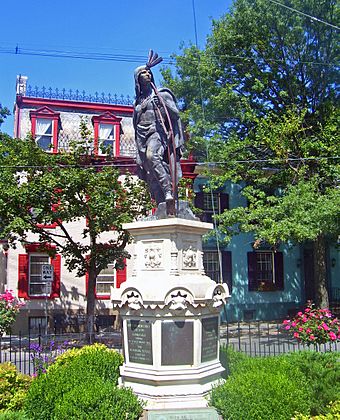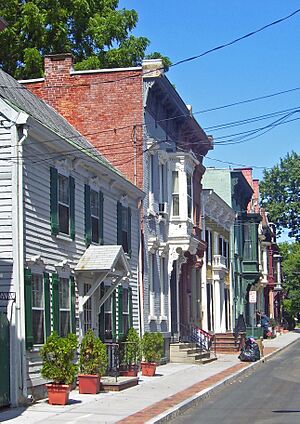Stockade Historic District facts for kids
Quick facts for kids |
|
|
Stockade Historic District
|
|

Statue of Lawrence the Indian
at center of Stockade District, 2008 |
|
| Location | Roughly bounded by Mohawk River, RR tracks, and Union St. (original), and 16, 18, and 20 S. Church St. (increase), in Schenectady, New York |
|---|---|
| Area | 82 acres (33 ha) |
| Built | 1735–1800 |
| Architect | Multiple |
| NRHP reference No. | 73001267 and 84002963 |
| Added to NRHP | April 03, 1973 (original) September 07, 1984 (increase) |
The Stockade Historic District is a special old neighborhood in Schenectady, New York. It sits right by the Mohawk River. This area is the oldest part of the city. People have lived here for more than 300 years!
Many buildings here are very old. Some are even over 200 years old. The National Park Service says it has the most old homes in the country. In 1962, Schenectady made it the first local historic district in New York. This means it's protected because of its history.
Famous people lived here too. Joseph C. Yates was a New York Governor. Elizabeth V. Gillette was a doctor. She was also the first woman from upstate New York elected to the state assembly.
Contents
Exploring the Stockade District
The Stockade District is shaped like a wedge. It covers about 82 acres. The Mohawk River is to the north. Old railroad tracks are on the east side. Union Street forms most of its southern edge.
This area is mostly flat. It has many small, two-story houses close together. At its center is a round plaza. Here you can see a statue of Lawrence the Indian. He was a Mohawk person. He helped the settlement after a big disaster.
A Look Back: History of the Stockade
The history of the Stockade District is really the history of Schenectady itself. Over time, the city grew much bigger. But the Stockade kept its unique feel.
Early Days: Settlers and a Stockade
In 1661, Dutch settlers came here. They were mostly traders. They wanted to do business with Native Americans. They built twelve houses. These were surrounded by a wooden fence called a stockade. This was the start of Schenectady.
Later, in 1674, the area became part of British New York. This happened after a peace treaty.
The Schenectady Attack
In 1690, during a war, French troops attacked. They had Native American allies. They found Schenectady's stockade was not well guarded. Many houses were burned. Most people were killed or taken prisoner. This event is known as the Schenectady massacre.
A Mohawk man named Lawrence helped the Dutch. He encouraged them to rebuild. By 1692, the community was strong again. The stockade was rebuilt even bigger.
Growing and Changing Times
The stockade grew to reach the river by 1763. This was after many wars. Later, people in the colonies were unhappy with British taxes. A "Liberty!" flag was raised here. It protested a tax law called the Stamp Act 1765.
During the American Revolutionary War, Schenectady was important. George Washington visited the area three times. After the war, the stockade was taken down. The village kept growing. It was a main stop for people traveling west.
The 1800s: Bridges and Colleges
In the early 1800s, an engineer named Theodore Burr built a bridge. It was a wooden suspension bridge over the Mohawk River. It was one of the longest in North America at the time.
Union College was founded here in 1795. It was America's first college open to all religions. Its first building was in the district. In 1814, the college moved to its current location.
In 1819, a big fire destroyed many buildings. Six years later, the Erie Canal was finished. Most business moved away from the Stockade. This helped save the old homes. Schenectady then grew with factories like General Electric.
The 1900s: Progress and Protection
Elizabeth Gillette moved to Union Street in 1900. She started her medical practice. In 1920, she made history. She was the first woman from upstate New York elected to the state assembly. She served one term.
Theodore Burr's bridge burned down in 1909. New bridges were built nearby. By the mid-1900s, the neighborhood started to look run down. Some old buildings were torn down.
But residents cared about its history. In 1957, they formed the Stockade Association. Five years later, they convinced the city to protect the area. This made it New York's first historic district.
Keeping the Stockade Special
The city of Schenectady protects the Stockade. A group called the Historic Commission helps. If someone wants to change an old building, they need approval. This keeps the historic look of the neighborhood.
The Historic Stockade Association is very active. They help residents and protect the community's history. They publish a newsletter. They also organize tours and fun events. For example, every Valentine's Day, pink flamingos appear by the Lawrence statue. People even sing along to them!
Images for kids





